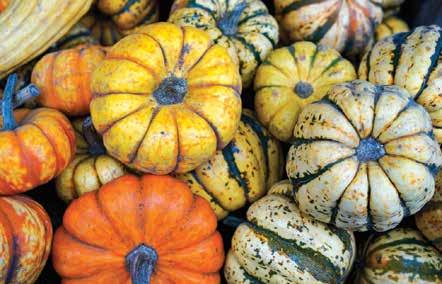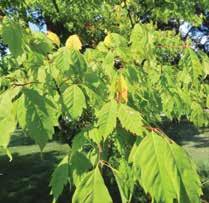
5 minute read
The Face of a Tree
a tribute to Mother Nature’s handiwork
“There is something in a face and air and a peculiar grace, which boldest painters cannot trace.” Those were the words of English poet William Somerville (1675-1742). I imagine he was standing mesmerized as he looked deep into the face of a magnificent tree standing alone at the edge of a prairie in what would one day be an area called Kansas or Missouri. I too am charmed by the face of a tree.
Just as the roots are the heart of the tree, leaves are the face of a tree. Holding the large leaf of a giant Catalpa tree or holding the strong, firm leaf of a young Burr Oak tree, we can see the face of the tree as we realize this leaf manufactures all of the food for this tree. It is one of Mother Natures miracles. The roots of the tree absorb moisture and nutrients and send it up through millions of tiny cells to the end of hundreds of branches and twigs then going through a leaf stem filled with many veins to many more veins in each leaf. Through the process of photosynthesis all leaves manufacture food and release excess oxygen into the air. This includes the leaves of grass, the leaves of weeds, the leaves of poison ivy, the leaves of a petunia, all leaves.
This process takes energy from sunlight, water and moisture sent up from the roots, carbon dioxide from the air mixing this together and make sufficient food for the tree to often grow into 50 foot giants in Kansas and Missouri and 200-foot giant Redwoods in the Pacific Northwest and every tree of every size in between.
If you really want to see this mind blowing site, take a one hour walk at the Overland Park Arboretum and walk on the south side of Wolf creek on lower bluff trail and see the hundreds of thousands of beautiful faces of the thousands of naturally planted Pawpaw trees that have been growing there for about 12,000 years, from seed and from sprouts which gives the pawpaws the famous pawpaw patch history.
As good fortune would have it I can sit on our back porch and see the faces of many 50’ to 60’ tall forest trees. On a breezy day the faces of these trees take on many dimensions and show a lovely exactness that is hard to duplicate or explain.
Early spring starts with tiny leaves breaking into the open air as they unfurl from the tight leaf bud that has been protecting them all winter. Sometimes they get caught in a late freeze and the cold weather slows them down but rarely kills them. Their tiny damaged faces the size of a penny continue to open and will eventually with warm weather, sun and moisture be fully opened and in some cases reach 8 inches as a long Burr Oak leaf or a tulip shaped medium green leaf of the Tulip Tree.
The face of a baby tree is as endearing to see as anything on planet Earth. The tiny leaf of the new born tree has just enough energy, derived from the seed from which it sprouted, to make its roots grow about 1/4” each day for four or five days. The tip of the tiny white root is as a thimble, forcing its way as it searches for moisture in the ground. Without moisture, it will perish.
Mother Nature gives most trees the ability to produce numerous seeds each year and most of them will not germinate or survive into larger trees. If they did, the forest would be overcrowded. Many wild and native animals eat the seeds including birds, rodents, deers, opossums, foxes and squirrels. Seed not eaten has a slight chance of germinating and sprouting the first set of leaves, and most of these are also eaten by herbivores. Of the one tiny tree that survived this onslaught it must compete with other trees including its mother tree. Every tree that remains is miraculous.
I look at the face of the trees. I reach out and hold a small branch laden with leaves, exploring tops and undersides. With deep gratitude I say, “Thanks for what you do and how you do it.” No need to detail what is well-known. With a gentle breeze and rustling of the leaves I know the tree understands and expects me to do more for all living things.
Photos by Ken O’Dell.
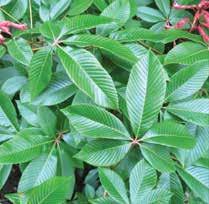
Faces of Ivy-leaved Maple Faces of Red Buckeye
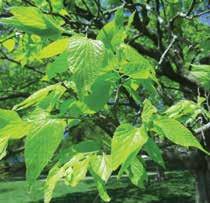
Faces of the great Hackberry tree Faces of Trees at Linda Hall Library
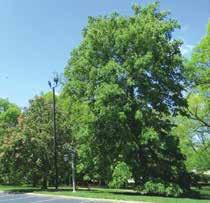
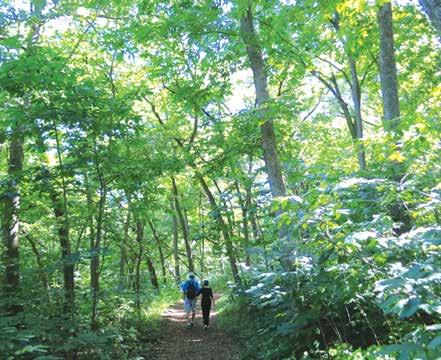
Faces on Lower Bluff Trail
KEN O’DELL Expert Plantsman
Ken O’Dell is the Kansas City Regional Leader of the Kansas Native Plant Society. He is a long-time volunteer at the Overland Park Arboretum. You may reach him via email at Ken@springvalleynursery.com.
Missouri Wildflowers
Nursery
9814 Pleasant Hill Rd Jefferson City MO 65109 www.mowildflowers.net mowldflrs@socket.net 573-496-3492
Meet us at one of these locations this fall in the KC area. Give us your order by Tuesday before a sale, or shop from our selection at the sale.
Backyard Bird Center 816-746-1113. 6212 NW Barry Road, KC MO 64154. Platte Land Trust Native Plant Sale. August 28, 10:00 am - 12 noon Anita B. Gorman Cons. Discovery Center. 4750 Troost Ave. KC MO 64110. Missouri Prairie Foundation Native Plant Sale www.moprairie.org. September 18, 11 am - 1:30 pm Shawnee Indian Mission. 3403 West 53rd St, Fairway KS 66205 Shawnee Indian Mission Fall Festival & Native Plant Sale. Info: shawneeindianmission.org. October 9, 10 am - 5 pm
The Nursery Is Open at 9814 Pleasant Hill RD, Jefferson City MO 65109. Weekdays Year-Round: 9 am - 5 pm, Fall Weekends: August 28 - October 10, Saturdays: 9 am - 5 pm, Sundays Noon - 5
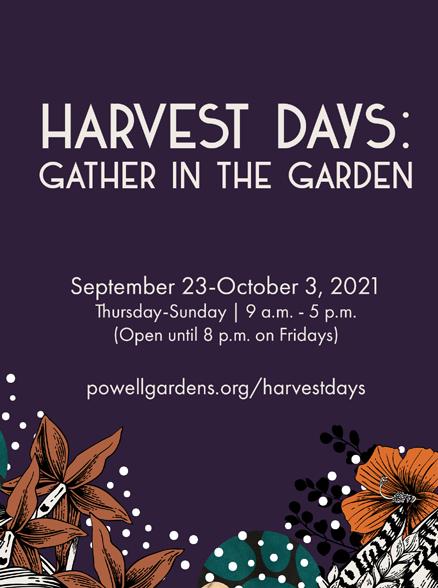
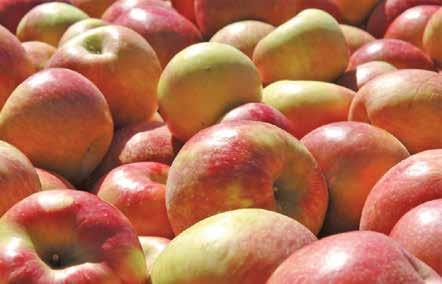

U-PICK FARM FUN FOR 20 YEARS!
• Over 23,000 Mums in 52 Varieties, 7 colors, 3 bloom times! • U-Pick Apples, Veggies, Sunflowers and Pumpkins • Friendly Farm Animals • Jumping Pillows and Plenty of Outside Play Area • Pumpkin Donuts and Cider Slushies
FAMILY SEASON PASSES AVAILABLE 177th and Holmes • 816.331.1067 www.johnsonfarms.net
